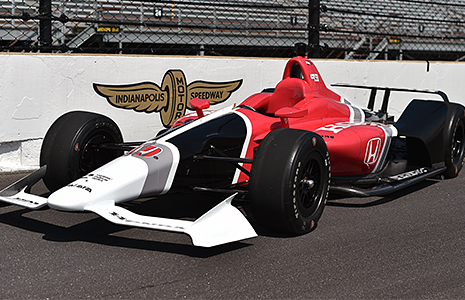LEXINGTON, Ohio — Graham Rahal likes the positive feedback he’s hearing around the paddock about the Verizon IndyCar Series’ new car for 2018.
Perhaps even more important, he likes what he sees in Dallara’s universal aerodynamic bodywork kit that was tested for the first time Tuesday at Indianapolis Motor Speedway.
After finishing his initial practice today for Sunday’s Honda Indy 200 at Mid-Ohio, Rahal complimented the INDYCAR leadership trio who guided the universal kit development: Jay Frye, president of competition and operations; Bill Pappas, vice president of competition/race engineering; and Tino Belli, director of aerodynamic development.
 “Jay has been working on it for a while,” Rahal said. “I don’t know that we all give Jay enough credit for finally pointing this thing in the right direction.
“Jay has been working on it for a while,” Rahal said. “I don’t know that we all give Jay enough credit for finally pointing this thing in the right direction.
“Personally, I’ve felt for the last 10 years the cars have just got progressively, in my opinion, uglier. Now, we’re finally getting back to what an Indy car should be like. I salute Jay, Bill Pappas, Tino (Belli) and that team for what they did.”
The universal kits, produced by Dallara, will be applied to the Dallara IR-12 chassis that has been used in the Verizon IndyCar Series since 2012. All teams will employ the universal kit in 2018, ending three seasons of aero kit competition between Chevrolet and Honda. It allows the two manufacturers to focus solely on engine development going forward.
The Honda- and Chevrolet-powered cars that tested in Indy are on display this weekend in garages adjacent to pit lane at Mid-Ohio Sports Course. (The Honda car is shown at right.)
On Tuesday, longtime Indy car drivers Juan Pablo Montoya and Oriol Servia will test the cars on Mid-Ohio’s 2.258-mile permanent circuit with a configuration that will be used on short ovals, road and street courses. The previous test was with the superspeedway configuration.
“The response I’m hearing from Juan and Oriol, having driven it, they were both blown away by how good it was out of the box,” Rahal said. “We’ve all tested and we’ve all driven new cars, and a lot of times it’s not pretty. When we got this (IR-12) chassis for the first time in 2012, it was awful to drive. We had to change a lot to adapt to that.
“I’m definitely excited to get in it. I love the looks of it. I think the road-course car is even sexier. That’s going to be even better. And the biggest thing is it’s going to race better. One hundred percent. One hundred percent. On the ovals, it will race a lot better, particularly short ovals.”
Rahal, who drives the No. 15 Steak ’n’ Shake Honda for Rahal Letterman Lanigan Racing, won at his home Mid-Ohio track in 2015.
“The bigger thing for me with the new car, that I’m more excited about and told somebody this yesterday, the sidepods are forward and they’re higher,” he said. “The biggest concern I’ve ever had in these things isn’t getting hit in the head with something, which maybe it should be. But there’s been a lot of side area that's exposed for the legs to get hit. If you ever spun mid-track and somebody T-boned you, it would be an ugly deal.
“Now the sidepod's going forward quite a bit – it's a little bit higher, got the nice new carbon crash structure on the side – that will help a lot. I'm excited about that."
The new design also allows for the addition of a windscreen, which INDYCAR is researching to add as a cockpit safety measure.
“It’s been quite a process,” Rahal said. “Jay has been working on this since Justin (Wilson’s 2015) accident. I know he’s been pretty quiet about that. The key is clarity, distortion, size. There’s a lot of elements that go into this.
“You have to find a way to properly mount it. It’s got to be strong. It’s got to withstand an accident like Josef (Newgarden) had at Texas last year. They’re working hard on it. If it comes, I’ll be excited.”